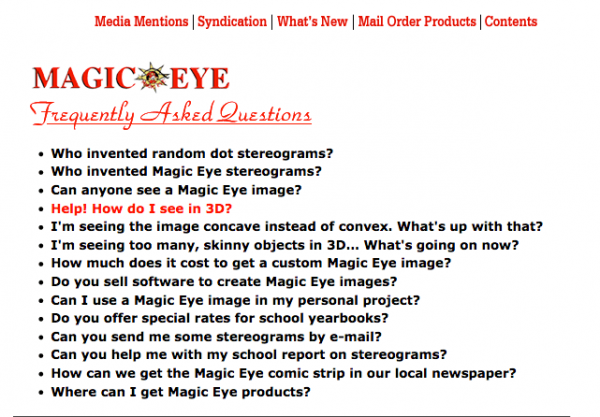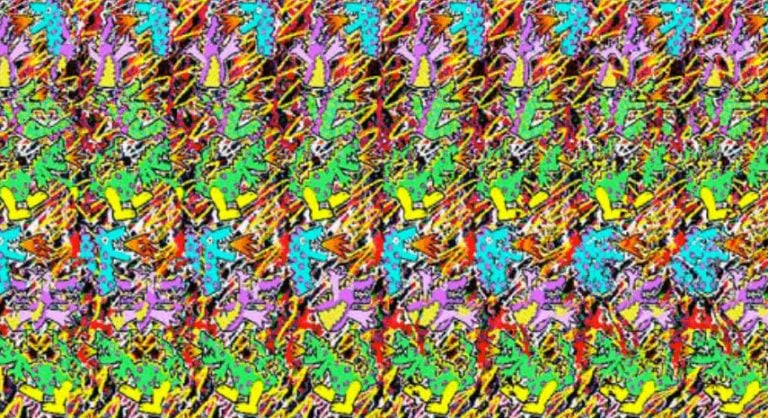Like a large percentage of the population, I have never been able to see a Magic Eye picture. It’s never really bothered me, although I am acutely aware this is actually layers of defense built up over years of “It’s a horse! HORSE. Look there’s the hoof, there’s the tail. It’s sooo easy, no wait it’s a fairy. A fairy. Those are wings” and that, deep down, it bothers me greatly.
It’s easy though. Kids can do them.
Here are some of the easy, easy ways to do Magic Eyes.
a) Cross your eyes, put the page on your nose, then slowly pull out.
b) Stand 30cm from the page and slowly walk towards the page.
c) Stand 15cm from the picture and just make your eyes blur, and focus on nothing.
d) Focus on one sharp point to the exclusion of everything else.
Love Music?
Get your daily dose of metal, rock, indie, pop, and everything else in between.
e) Sort out the energy flow of the room first by rearranging the furniture, then once the blockage is removed, cross your eyes, put the page on your nose, then slowly pull out.
None of these techniques work. For me. I was beginning to believe that I was just one of those people who simply cannot do Magic Eye pictures. Whether it’s something to do with my physical eyesight, my brain’s perception of various light waves, unexamined childhood trauma, or my guttural flora, I was convinced it was hardwired.
So I went to the very top to find out.
The Magic Eye website wasn’t very helpful, and almost snarky in its advice, although its charming Geocities design made me happy such an official hub exists.
“Can anyone see a Magic eye image?” was one of the questions asked frequently, although no metric was given to define the frequency of such requests.
“DEPTH PERCEPTION depends on having two eyes”, they explain bluntly. “Most people who have depth perception can see a Magic Eye image. People with impaired depth perception or people who have one eye which is extremely dominant (as in amblyopia) will have more difficulty seeing the image.”
Brilliant.
 If this article doesn’t make the ‘media mentions’ I won’t be happy.
If this article doesn’t make the ‘media mentions’ I won’t be happy.
Seeking more scientific reasoning, I spoke to Stuart Marlin, who is Senior Lecturer in Psychology at the University of Newcastle.
He teaches Neuroscience and Perception to first and third year Psychology students. As far as I’m aware, he has never worked in the FAQ section at Magic Eye.
“There are a couple of reasons why people can’t see the magic eye images”, he begins. “The most basic one would be poor or no stereovision.”
So the site was correct, albeit, in a “Leonardo DiVinci invented the helicopter ‘cos he drew it once” kinda way.
“Stereopsis — or depth from retinal disparity — is a perceptual ability that develops between about three months and four years of age. It requires both eyes being able to lock the eye’s fovea on targets at a specific distance. Things closer than that object will be displaced away from the fovea on the retina of each eye relative to the distance of that near object from the object you are actually looking at.
“The brain uses this location disparity to calculate the objects depth because it follows simple rules of physics and geometry. It can tell objects in front of the target from objects behind the target by whether the retinal images are displaced on the same side — ie. to the left in the left eye and to the right in the right eye — or are “crossed” (ie to the right in the left eye and to the left in the right eye).
“This skill develops with experience with objects in the world, but it requires the eyes to work properly.
“People with lazy eye (strabismus) have two eyes that do not easily lock on to the same object. One (dominant) eye will do this job while the other either looks off to the side or wanders. The brain ignores this unreliable eye and just uses the dominant one for obtaining information about the world, but because both eyes are not working together, the brain does not develop stereopsis.
“If uncorrected before about four years of age, the critical period finishes and so even if you correct it later, the brain has finished with that development and won’t then correct. The person will never ever have stereopsis. They will be ‘stereo blind’. These people will not see magic eye pictures, red/green glasses based stereograms, 3D stereo movies etc.
“Both eyes work fine, but the brain just can’t use the information to calculate depth.”
So, basically, if you didn’t get that figured out by the age of four, you’re doomed to a life of steroblindness: unsatisfying magic eyes, and a severely-limited appreciation of Avatar.
 I got it. It’s, it’s…modern art?
I got it. It’s, it’s…modern art?
But the reverse is not necessarily true. You may love a good 3D film, but still not be able to see the unicorn from the squiggle trees, so to speak. If you aren’t stereoblind, there is hope.
Marlin stresses that there are many cues to depth. So, your lack of magic eye wizardry could be for a completely separate reason. He explains that specific tests were designed in the ’40s during the war to screen for the disorder, as people who are stereoblind cannot be pilots.
These tests revealed a range of ability for using retinal disparity. “So the second reason [for failing at Magic Eye] might be they just have relatively poor stereoacuity”, he continues. “Other eye disorders can also affect this such as astigmatism which will distort the image in one direction making the brain’s calculations more difficult.
“These stereo acuity tests and most simple 3D stimuli have simple objects that are matched between the left eye and right eye. So that is fairly simple for the brain. But magic eye pictures are based on the work of Béla Julesz from the 1960s. His work shocked the perception world because it showed the brain takes a point from the right eye’s image and tries to find a match from the left eyes image. And it does this for every point in the image.
“The number of possible matches is infinitely large, but it tries and tries and tries. Once a pattern of matches starts to occur, the brain locks on to that dot disparity as its starting place for all the dots and then looks for places in the image where that does not work. This is not as hard as it sounds because in the Julesz images and the Magic Eye most of the dots make up a single depth that is the background and a smaller object floats in front (or behind) or there is a gradual change from that background depth to a point in front (or behind).
“Depending on how complex the magic eye image is, that process can take a short time or a long time even for people with good stereovision.
Marlin explains there are actually scientifically-based techniques for seeing a difficult image. He lays out a few common ones.
1) You have to get the viewing distance right. There is a sweet spot where the brain works on these problems best and that is often determined by the computer algorithm that made the image.
2) You have to look PAST the actual depth of the printed image. For example, if the image is about 25 cm from your eye, you have to fixate your eyes at 50cm distant. This is made easier if the picture is behind reflective glass or on a computer screen where you can simply look at your own reflection.
3) When the brain starts to get the solution it creates a false 3D image and your reflex is to look at that implied depth location which of course breaks strategy 2, and the whole thing falls apart.
“So when you start to see the object, you have to resist that reflex. I suggest people put their thumbs in their ears and wiggle their fingers on both hands. This keeps your attention on the depth of your reflection but because the hands are off to the side, it does not interfere with the object that is usually at the centre of the magic eye image – and is fun to watch people do this.”
There in lies the third, and perhaps the most under-reported reason. Due to the sustained attention model. Or as Marlin explains, “People who are impatient do not do well with this task. People who can’t learn to inhibit the reflex that happens when the image starts to resolve also don’t do well, but with practice that can get better.”
Finally, don’t despair. This stuff was designed to bend our brains.
“There are some magic eye images that are harder than others”, he concludes. “There are even some where there are different images in the picture, depending on which solution your brain adopts.”
So maybe it’s a horse AND a fairy.


































